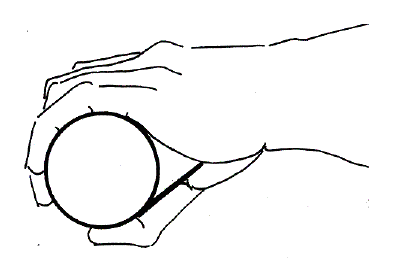Rowing Blisters: Part 3
So if it’s not something on the handle rubbing your hands causing your blisters could it be your hands shifting, moving, creating friction? Or squeezing, pinching tiny folds of flesh (yes, even in the thinnest!) against the oar handle? Into the sculling grip?
Sculling or rowing, the best grip is light with your fingers loose and relaxed. You have leverage, modern oars and sculls are light and now that you’ve cleaned the grips there’s no need to hold on tightly to control the blade.
Good rowing grip
Good rowing hands work lightly and separately.
A good outside hand keeps the shape of a loose fist during the wholestroke (top knuckles horizontal with the wrist, palm free of the handle so that there is no gripping)

Outside Hand Grip in Rowing
and its job is to
- control the height of the handle
- place the blade in the water
- tap down to take the blade out of the water
It does this by applying enough pressure on top of the handle.
And the inside hand?
A good inside hand also holds the handle in a loose fist during the stroke. Its only job is to turn the handle, feathering the blade just after the finish and squaring it up again just before the catch. Use your wrist: twist your wrist downwards to feather, roll it up to square

Feathering and Squaring with the Inside Hand in Sweep Rowing
Good sculling grip
A good sculling grip also uses a loose fist; the difference is that when you’re sculling you hold your thumbs on the end of the grip. Roll the grip out with your fingers to feather; back into your hand to square:

Finger Feathering and Squaring in Sculling
If your hands are big enough, if your handle is small enough you can also finger-feather when you’re rowing. In practice, and especially for people with small hands, you use a combination of the wrist and finger movement. The best movement has the smallest wrist movement.
Getting rid of the tension in your hands will mean fewer blisters – yes, I did say fewer – we haven’t eliminated them all but we do still have a few more tricks up our sleeves . . .







This Post Has One Comment
Using old towelling I make tubes, closed at one end, and about 150mm long. These are pulled onto the blade handle and WETTED. It is not necessary to tie them on. They are removed and rinsed after each outing. They give a roughness to otherwise smooth, round handles. I think this improves grip and the feel of the blade. Sweat is absorbed. I don’t get blisters from daily 8k rows.
Have fun.